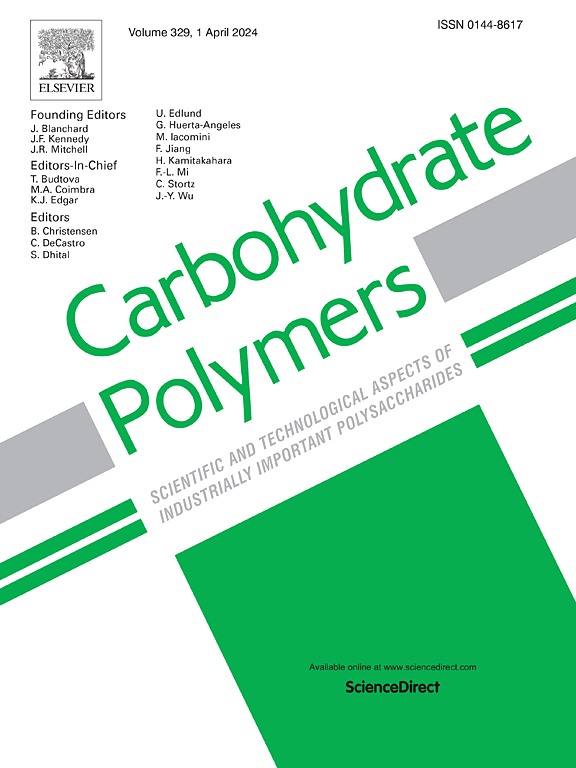一种基于海藻酸钠/丝纳米纤维的柔性薄膜传感器,用于火焰环境中环境温度和人员呼吸的实时监测
IF 10.7
1区 化学
Q1 CHEMISTRY, APPLIED
引用次数: 0
摘要
天然聚合物被认为是制备新一代智能传感器的有力候选者,但其阻燃性和热稳定性较低,限制了其在火灾环境中的应用。在此,我们通过溶液铸造和自组装策略,开发了一种完全由天然丝纳米纤维、海藻酸钠和植酸组成的新型柔性薄膜(SSGP)。它具有可靠的拉伸性能(11.01 MPa),高阻燃性(LOI达到38%)和热稳定性。其中,SSGP不仅在不同温度(50 ~ 125℃)下表现出敏感且可逆的反应,GF为10.8,而且在暴露于火焰后2.2 s内触发警告而未被焚烧。此外,SSGP对环境湿度变化(22- 94% RH)有响应,可用于呼吸监测,响应/恢复时间仅为0.76 s/1.01 s。此外,基于天然聚合物的SSGP在30天内保持了39.8%的可降解性。因此,SSGP有可能作为核心组件集成到传感器中,用于炼钢厂、消防救援、战场和其他火焰环境中人员的环境温度和呼吸实时监测。本研究为天然高分子材料在柔性多功能传感器中的应用提供了新的思路。本文章由计算机程序翻译,如有差异,请以英文原文为准。

A flexible film sensor based on sodium alginate/silk nanofiber for real-time monitoring of the ambient temperature and personnel respiration in flame environment
Natural polymers are considered powerful candidate for preparing a new generation of intelligent sensors, however, their application in fire environment is limited restricted by the low flame retardancy and thermal stability. Herein, we developed a novel flexible film (SSGP) entirely composed of bio-mass, namely natural silk nanofibers, sodium alginate and phytic acid, via solution casting and self-assembly strategy. It exhibited reliable tensile properties (11.01 MPa), high flame retardancy (LOI reached 38 %), and thermal stability. Specifically, SSGP not only showed sensitive and reversible response at different temperatures (50-125 °C) with a GF of 10.8, but also triggered warning within 2.2 s of being exposed to a flame without being incinerated. Moreover, SSGP responded to humidity changes in the environment (22-94 % RH) and could be used for respiratory monitoring, with a response/recovery time of only 0.76 s/1.01 s. Additionally, SSGP based on natural polymers retain degradability (39.8 % within 30 days). Thus, SSGP had the potential to be integrated as a core component into sensor for real-time monitoring of ambient temperature and respiration of personnel in steelworks, fire rescue, battlefield and other flame environment. This study may provide new insights into the application of natural polymers in the flexible multifunctional sensor.
求助全文
通过发布文献求助,成功后即可免费获取论文全文。
去求助
来源期刊

Carbohydrate Polymers
化学-高分子科学
CiteScore
22.40
自引率
8.00%
发文量
1286
审稿时长
47 days
期刊介绍:
Carbohydrate Polymers stands as a prominent journal in the glycoscience field, dedicated to exploring and harnessing the potential of polysaccharides with applications spanning bioenergy, bioplastics, biomaterials, biorefining, chemistry, drug delivery, food, health, nanotechnology, packaging, paper, pharmaceuticals, medicine, oil recovery, textiles, tissue engineering, wood, and various aspects of glycoscience.
The journal emphasizes the central role of well-characterized carbohydrate polymers, highlighting their significance as the primary focus rather than a peripheral topic. Each paper must prominently feature at least one named carbohydrate polymer, evident in both citation and title, with a commitment to innovative research that advances scientific knowledge.
 求助内容:
求助内容: 应助结果提醒方式:
应助结果提醒方式:


